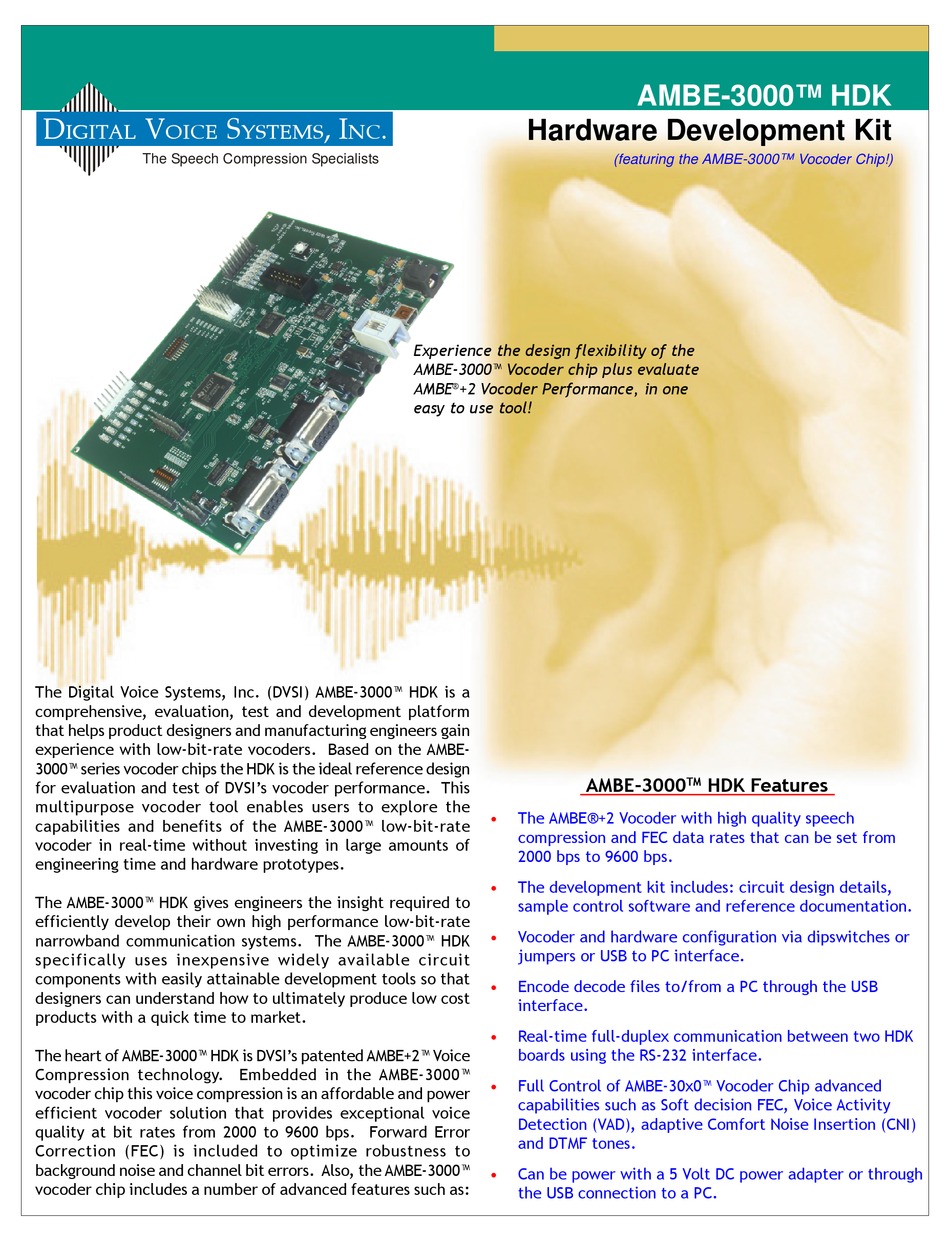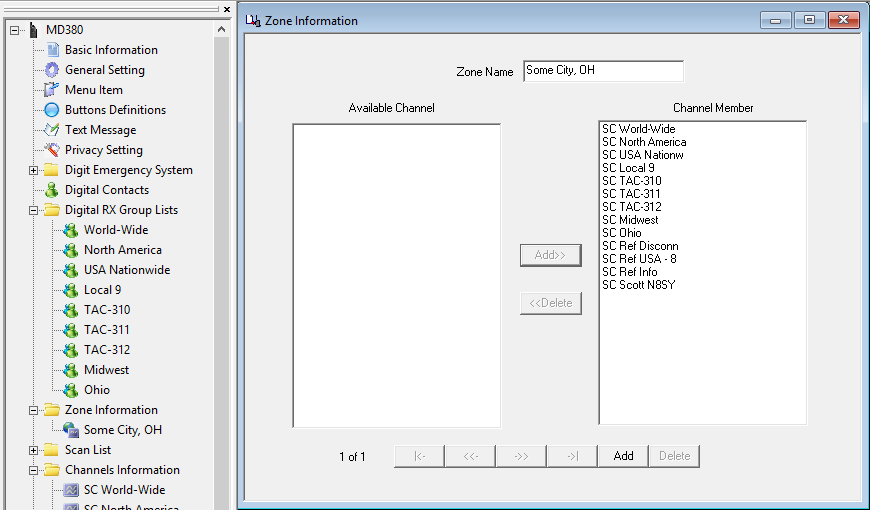Ambe Codec Software
{{lead too md short|date=January 2011}}
Ambe Codec Software Installation 6,4/10 4676 reviews H.264 is a popular standard for high definition digital video, and for good reason. A codec based on the H.264 standard compresses a digital video file so that. This turns the packets from 72 bits long into 49 bits long packets. The next step in the chain would be an AMBE decoder. This could be a dongle with an AMBE vocoder chip on it, or it can be software; when choosing the latter, please verify that this is legal where you live since the AMBE codec is patented. 1.4 'Voice Codec' shall mean the AMBE-2020™ Vocoder Chip integrated circuit, the AMBE Voice Compression Software, firmware and associated documentation, including modifications, enhancements and extensions made by or for Digital Voice Systems, Inc. (DVSI) and including. 1: Software-Defined Radio Radio technology is in transition to software-defined. Software-defined radio has the capability of being changed and improved after it leaves the manufacturer. The conservative manufacturers only use this opportunity to distribute updates of their own software. The forward-looking ones make open platforms.
Multi-Band Excitation (MBE) is a series of proprietary speech coding standards developed by Digital Voice Systems, Inc. (DVSI).
Overview[edit]

In 1967 Osamu Fujimura (MIT) showed basic advantages of the multi-band representation of speech ('An Approximation to Voice Aperiodicity', IEEE 1968). This work gave a start to development of the 'multi-band excitation' method of speech coding, that was patented in 1997 (now expired) by founders of DVSI as 'Multi-Band Excitation' (MBE). All consequent improvements known as Improved Multi-Band Excitation (IMBE), Advanced Multiband Excitation (AMBE), AMBE+ and AMBE+2 are based on this MBE method.
AMBE is a codebook-based vocoder that operates at bitrates of between 2 and 9.6 kbit/s, and at a sampling rate of 8 kHz in 20-ms frames. The audio data is usually combined with up to 7 bit/s[citation needed] of forward error correction data, producing a total RF bandwidth of approximately 2,250 Hz (compared to 2,700–3,000 Hz for an analogue single sideband transmission). Lost frames can be masked by using the parameters of the previous frame to fill in the gap.
Usage[edit]
AMBE is used by the Inmarsat and Iridiumsatellite telephony systems and certain channels on XM Satellite Radio and is the speech coder for OpenSkyTrunked radio systems.
AMBE is used in D-STARamateur radio digital voice communications. It has met criticism from the amateur radio community because the nature of its patent[1] and licensing runs counter to the openness of amateur radio, as well as usage restriction for being 'undisclosed digital code' under FCC rule 97.309(b) and similar national legislation.[2]
The NXDN digital voice and data protocol uses the AMBE+2 codec. NXDN is implemented by Icom in the IDAS system and by Kenwood as NEXEDGE.
APCO Project 25 Phase 2 trunked radio systems also use the AMBE+2 codec, while Phase 1 radios use the earlier IMBE codec.
Digital Mobile Radio (DMR) and Motorola's MOTOTRBO use the AMBE+2 codec.
Licensing[edit]
Use of the AMBE standard requires a license from Digital Voice Systems, Inc. While a licensing fee is due for most codecs, DVSI does not disclose software licensing terms. Anecdotal evidence[citation needed] suggests that licensing fee begin from between $100,000 to $1 million. For purposes of comparison, licensing fees for use of the MP3 standard started at $15,000. For small-scale use and prototyping, the only option is to purchase a dedicated hardware IC from DVSI. These ICs can be purchased for less than $100 in small quantities.[3]
DSP Innovations Inc. offers a software implementation of APCO P25 Phase 1 (Full-Rate) and Phase 2 (Half-Rate) codecs as well as DMR and dPMR codecs. A technology licence from DVSI is required.The patent for IMBE has expired.
Alternatives[edit]
Codec2 is an open source alternative which uses half of the bandwidth of AMBE to encode speech of similar quality,[citation needed] created by David Rowe and lobbied by Bruce Perens. Codec2 still continues to evolve, with additional 'modes' being developed, refined and made available on a continuous basis. This has resulted in an open source codec that has progressively increased its robustness and performance – when subjected to some of the most challenging RF and acoustic environments.[4]
References[edit]
- ^US 6199037, John C. Hardwick, 'Joint quantization of speech subframe voicing metrics and fundamental frequencies', issued 2001-03-06, assigned to Digital Voice Systems Inc
- ^David Rowe. 'The Codec2 Project: Next-Generation Audio Codecs and Vocoders for Two-Way Radio'. Retrieved 16 February 2012.
- ^'DVSI Pricing Information'. www.dvsinc.com. Retrieved 8 April 2020.
- ^Bruce Perens. 'Codec2'. Retrieved 9 May 2012.
External links[edit]

Depending on your point of view, Jon Lech Johansen is either your hero or adversary. To the copyright industry, Jon Lech Johansen has been a detriment to their policy of control since the advent of DeCSS (Decrypt Content Scrambling System.)
At the age of 15, “DVD Jon” wrote a computer program that allowed users to copy DVDs. Then he posted it on the Internet. A Norwegian private school awarded him a prize for making an outstanding contribution to society. The Norwegian government indicted him.
Jon spent 3 long years in the Norwegian courts proving his innocence. The American movie industry pressured the Norwegian Economic Crime Unit to press charges against Jon Lech Johansen in 2000 for allegedly bypassing the CSS copy protection on DVDs.
Early on; Bruce Perens, K6BP, amateur radio and open source advocate voiced concerns about D-Star’s use of a proprietary vocoder. Asking; does it really fit into the spirit of the hobby? Bruce makes a strong argument that an Open Source vocoder needs to be developed.
In May 2008, he announced that he will investigate the development of an alternative codec. The Codec2 Project: Next-Generation Audio Codecs and Vocoders for Two-Way Radio.
In August 2009 David Rowe, VK5DGR, began designing and implementing a replacement codec under the GPL.
“Proprietary codecs typically have small, novel parts of the algorithm protected by patents. However proprietary codecs also rely heavily on large bodies of public domain work. The patents cover perhaps 5% of the codec algorithms. Proprietary codec designers did not invent most of the algorithms they use in their codec. Typically, the patents just cover enough to make designing an interoperable codec very difficult. These also tend to be the parts that make their codecs sound good.”
Two open source compatible codec’s that come to mind:
Thomson Multimedia and Fraunhofer Society originally controlled the patents and licensing of the MP3 audio codec. Tip-toeing around the patented parts of the algorithms the LAME encoder was developed as free software application used to encode audio into the MP3 file format.
You might be surprised to find out that formats like Mp3 are actually someone's intellectual property, because the vast majority of Mp3 players and encoders don't pay royalties and are based on easily available implementations that have been out for years.
The DivX codec (used to compress lengthy video segments into small sizes while maintaining relatively high visual quality.) was actually an attempt by the now defunct U.S. retailer Circuit City to develop a video rental system requiring special discs and players.
The Xvid codec became a primary free and open source competitor offering comparable quality. It too was developed by tip-toeing around the patented parts of the DivX algorithms.
Codec Download
Many codecs, containers, file formats and other systems have been hacked to pieces and continue to be despite being the property of one party.GIF images (up till 2006 when the patents expired) used a patented LZW compression scheme.
PDF is owned by Adobe but has been implemented by numerous others. there are many open-source and non-approved PDF viewers, editors and creators.
Unauthorized FLV players and converters exist as well. The same can be seen with real audio, real video, various Quicktime codecs, Dolby Digital AC3, AAC, and many others.
Ambe Codec Software Windows 10

Ambe Codec Software Windows 10
Think about it...... Do you like your freedoms? Thank those who have taken the time reverse engineered something. Welcome those types with open hands to the hobby. Those types of experimenters are just what this hobby once was and still can be.{Update May 2010}
Interestingly enough the Digital Speech Decoder and xMBE codec library - can decode and recover the audio from P25 (Phase 1) IMBE, D-Star (AMBE), as well as Mototrbo/DMR (AMBE+2). The open source software was unveiled by anonymous authors in May 2010. It seemsto have possibly stemmed from the May 2008 OP25 project, that provides asoftware IMBE voice encoder/decoder. APCO Project 25 traces back to theearly 1990's required publication of the IMBE and AMBE codec algorithms, whichof course is how both projects came about.
It is important to note that so far there have been no take-down or patent violations filed from DVSI for these hobbyist adventures. It should also be noted that the important patent claims may expire in 2015. Basically all patents covering the AMBE-1000 chip have either expired or are not enforceable, due to disclosures made by DVSI. See Bruce Peren's AMBE Exposed document for further information.
Free Codecs Software Download
Also worth reading: The Right To Reverse Engineer